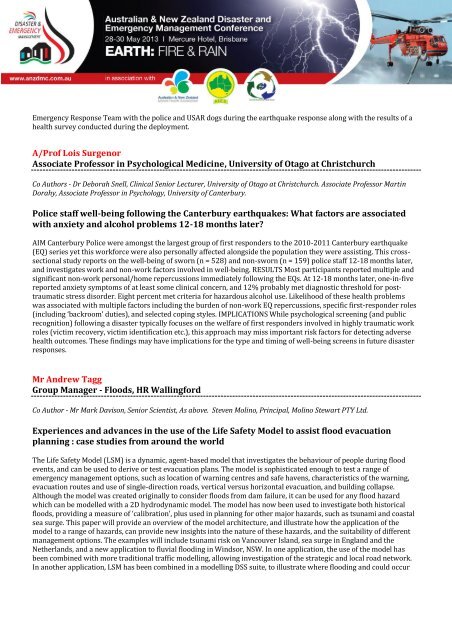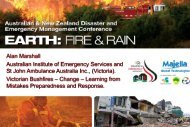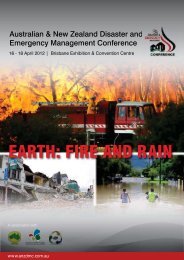Book of Abstracts 2013 - Australian and New Zealand Disaster ...
Book of Abstracts 2013 - Australian and New Zealand Disaster ...
Book of Abstracts 2013 - Australian and New Zealand Disaster ...
Create successful ePaper yourself
Turn your PDF publications into a flip-book with our unique Google optimized e-Paper software.
Emergency Response Team with the police <strong>and</strong> USAR dogs during the earthquake response along with the results <strong>of</strong> a<br />
health survey conducted during the deployment.<br />
A/Pr<strong>of</strong> Lois Surgenor<br />
Associate Pr<strong>of</strong>essor in Psychological Medicine, University <strong>of</strong> Otago at Christchurch<br />
Co Authors - Dr Deborah Snell, Clinical Senior Lecturer, University <strong>of</strong> Otago at Christchurch. Associate Pr<strong>of</strong>essor Martin<br />
Dorahy, Associate Pr<strong>of</strong>essor in Psychology, University <strong>of</strong> Canterbury.<br />
Police staff well-being following the Canterbury earthquakes: What factors are associated<br />
with anxiety <strong>and</strong> alcohol problems 12-18 months later?<br />
AIM Canterbury Police were amongst the largest group <strong>of</strong> first responders to the 2010-2011 Canterbury earthquake<br />
(EQ) series yet this workforce were also personally affected alongside the population they were assisting. This crosssectional<br />
study reports on the well-being <strong>of</strong> sworn (n = 528) <strong>and</strong> non-sworn (n = 159) police staff 12-18 months later,<br />
<strong>and</strong> investigates work <strong>and</strong> non-work factors involved in well-being. RESULTS Most participants reported multiple <strong>and</strong><br />
significant non-work personal/home repercussions immediately following the EQs. At 12-18 months later, one-in-five<br />
reported anxiety symptoms <strong>of</strong> at least some clinical concern, <strong>and</strong> 12% probably met diagnostic threshold for posttraumatic<br />
stress disorder. Eight percent met criteria for hazardous alcohol use. Likelihood <strong>of</strong> these health problems<br />
was associated with multiple factors including the burden <strong>of</strong> non-work EQ repercussions, specific first-responder roles<br />
(including ‘backroom’ duties), <strong>and</strong> selected coping styles. IMPLICATIONS While psychological screening (<strong>and</strong> public<br />
recognition) following a disaster typically focuses on the welfare <strong>of</strong> first responders involved in highly traumatic work<br />
roles (victim recovery, victim identification etc.), this approach may miss important risk factors for detecting adverse<br />
health outcomes. These findings may have implications for the type <strong>and</strong> timing <strong>of</strong> well-being screens in future disaster<br />
responses.<br />
Mr Andrew Tagg<br />
Group Manager - Floods, HR Wallingford<br />
Co Author - Mr Mark Davison, Senior Scientist, As above. Steven Molino, Principal, Molino Stewart PTY Ltd.<br />
Experiences <strong>and</strong> advances in the use <strong>of</strong> the Life Safety Model to assist flood evacuation<br />
planning : case studies from around the world<br />
The Life Safety Model (LSM) is a dynamic, agent-based model that investigates the behaviour <strong>of</strong> people during flood<br />
events, <strong>and</strong> can be used to derive or test evacuation plans. The model is sophisticated enough to test a range <strong>of</strong><br />
emergency management options, such as location <strong>of</strong> warning centres <strong>and</strong> safe havens, characteristics <strong>of</strong> the warning,<br />
evacuation routes <strong>and</strong> use <strong>of</strong> single-direction roads, vertical versus horizontal evacuation, <strong>and</strong> building collapse.<br />
Although the model was created originally to consider floods from dam failure, it can be used for any flood hazard<br />
which can be modelled with a 2D hydrodynamic model. The model has now been used to investigate both historical<br />
floods, providing a measure <strong>of</strong> ‘calibration’, plus used in planning for other major hazards, such as tsunami <strong>and</strong> coastal<br />
sea surge. This paper will provide an overview <strong>of</strong> the model architecture, <strong>and</strong> illustrate how the application <strong>of</strong> the<br />
model to a range <strong>of</strong> hazards, can provide new insights into the nature <strong>of</strong> these hazards, <strong>and</strong> the suitability <strong>of</strong> different<br />
management options. The examples will include tsunami risk on Vancouver Isl<strong>and</strong>, sea surge in Engl<strong>and</strong> <strong>and</strong> the<br />
Netherl<strong>and</strong>s, <strong>and</strong> a new application to fluvial flooding in Windsor, NSW. In one application, the use <strong>of</strong> the model has<br />
been combined with more traditional traffic modelling, allowing investigation <strong>of</strong> the strategic <strong>and</strong> local road network.<br />
In another application, LSM has been combined in a modelling DSS suite, to illustrate where flooding <strong>and</strong> could occur






